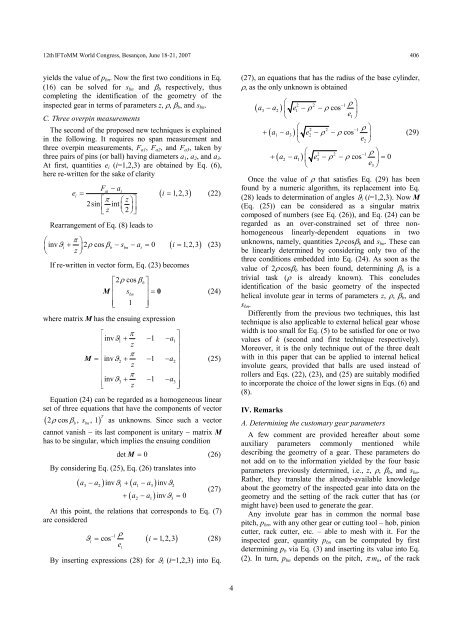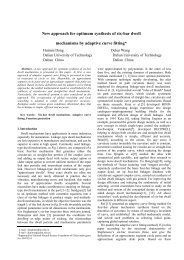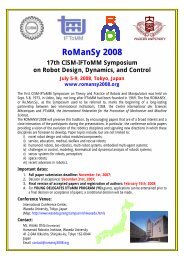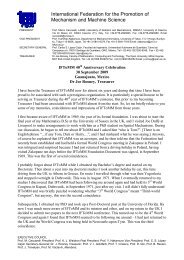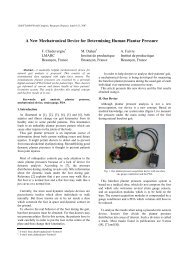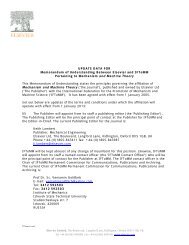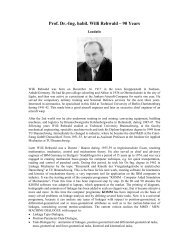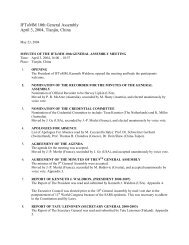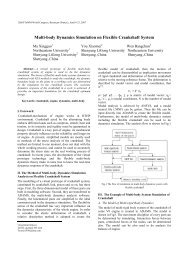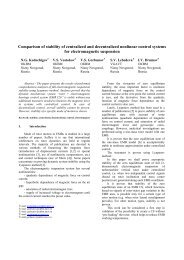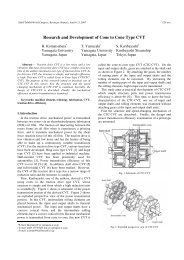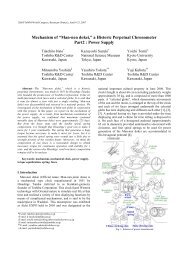A simple technique for measuring the base helix angle of ... - IFToMM
A simple technique for measuring the base helix angle of ... - IFToMM
A simple technique for measuring the base helix angle of ... - IFToMM
You also want an ePaper? Increase the reach of your titles
YUMPU automatically turns print PDFs into web optimized ePapers that Google loves.
12th <strong>IFToMM</strong> World Congress, Besançon, June 18-21, 2007 406<br />
yields <strong>the</strong> value <strong>of</strong> p bn . Now <strong>the</strong> first two conditions in Eq.<br />
(16) can be solved <strong>for</strong> s bn and β b respectively, thus<br />
completing <strong>the</strong> identification <strong>of</strong> <strong>the</strong> geometry <strong>of</strong> <strong>the</strong><br />
inspected gear in terms <strong>of</strong> parameters z, ρ, β b , and s bn .<br />
C. Three overpin measurements<br />
The second <strong>of</strong> <strong>the</strong> proposed new <strong>technique</strong>s is explained<br />
in <strong>the</strong> following. It requires no span measurement and<br />
three overpin measurements, F a1 , F a2 , and F a3 , taken by<br />
three pairs <strong>of</strong> pins (or ball) having diameters a 1 , a 2 , and a 3 .<br />
At first, quantities e i (i=1,2,3) are obtained by Eq. (6),<br />
here re-written <strong>for</strong> <strong>the</strong> sake <strong>of</strong> clarity<br />
Fai<br />
− ai<br />
ei<br />
= =<br />
⎡π<br />
⎛ z ⎞⎤<br />
2sin ⎢ int ⎜ ⎟<br />
z 2 ⎥<br />
⎣ ⎝ ⎠⎦<br />
Rearrangement <strong>of</strong> Eq. (8) leads to<br />
( i 1,2,3)<br />
⎛ π ⎞<br />
⎜invϑi + ⎟ 2ρ cos βb − sbn − ai<br />
= 0 i = 1,2,3<br />
⎝ z ⎠<br />
( )<br />
If re-written in vector <strong>for</strong>m, Eq. (23) becomes<br />
(22)<br />
(23)<br />
⎡2ρ<br />
cos βb<br />
⎤<br />
M<br />
⎢<br />
s<br />
⎥<br />
bn<br />
= 0 (24)<br />
⎢ ⎥<br />
⎢⎣<br />
1 ⎥⎦<br />
where matrix M has <strong>the</strong> ensuing expression<br />
⎡ π<br />
⎤<br />
⎢<br />
invϑ1 + −1<br />
−a1<br />
z<br />
⎥<br />
⎢<br />
⎥<br />
π<br />
M = ⎢invϑ2 + −1<br />
−a<br />
⎥<br />
2<br />
(25)<br />
⎢ z<br />
⎥<br />
⎢<br />
π<br />
⎥<br />
⎢invϑ3 + −1<br />
−a<br />
⎥<br />
3<br />
⎢⎣<br />
z<br />
⎥⎦<br />
Equation (24) can be regarded as a homogeneous linear<br />
set <strong>of</strong> three equations that have <strong>the</strong> components <strong>of</strong> vector<br />
( s )<br />
2ρ cos β , , 1 T<br />
as unknowns. Since such a vector<br />
b<br />
bn<br />
cannot vanish − its last component is unitary − matrix M<br />
has to be singular, which implies <strong>the</strong> ensuing condition<br />
det M = 0<br />
(26)<br />
By considering Eq. (25), Eq. (26) translates into<br />
( a − a ) invϑ<br />
+ ( a − a )<br />
( a a )<br />
invϑ<br />
3 2 1 1 3 2<br />
+ − invϑ<br />
= 0<br />
2 1 3<br />
(27)<br />
At this point, <strong>the</strong> relations that corresponds to Eq. (7)<br />
are considered<br />
ϑ<br />
ρ<br />
( i )<br />
−1<br />
i<br />
= cos = 1,2,3 (28)<br />
ei<br />
By inserting expressions (28) <strong>for</strong> ϑ i (i=1,2,3) into Eq.<br />
(27), an equations that has <strong>the</strong> radius <strong>of</strong> <strong>the</strong> <strong>base</strong> cylinder,<br />
ρ, as <strong>the</strong> only unknown is obtained<br />
a − a<br />
⎛<br />
e − ρ − ρ cos<br />
⎝<br />
( )<br />
ρ ⎞<br />
⎟<br />
⎠<br />
2 2 −1<br />
3 2 ⎜ 1<br />
e1<br />
⎛<br />
+ ( a − a ) ⎜ e − ρ − ρ cos<br />
⎝<br />
2 2 −1<br />
1 3 2<br />
ρ ⎞<br />
⎟<br />
e2<br />
⎠<br />
⎛ 2 2 −1<br />
ρ ⎞<br />
+ ( a2 − a1 ) ⎜ e3<br />
− ρ − ρ cos ⎟ = 0<br />
⎝<br />
e3<br />
⎠<br />
(29)<br />
Once <strong>the</strong> value <strong>of</strong> ρ that satisfies Eq. (29) has been<br />
found by a numeric algorithm, its replacement into Eq.<br />
(28) leads to determination <strong>of</strong> <strong>angle</strong>s ϑ i (i=1,2,3). Now M<br />
(Eq. (25)) can be considered as a singular matrix<br />
composed <strong>of</strong> numbers (see Eq. (26)), and Eq. (24) can be<br />
regarded as an over-constrained set <strong>of</strong> three nonhomogeneous<br />
linearly-dependent equations in two<br />
unknowns, namely, quantities 2ρ cosβ b and s bn . These can<br />
be linearly determined by considering only two <strong>of</strong> <strong>the</strong><br />
three conditions embedded into Eq. (24). As soon as <strong>the</strong><br />
value <strong>of</strong> 2ρ cosβ b has been found, determining β b is a<br />
trivial task (ρ is already known). This concludes<br />
identification <strong>of</strong> <strong>the</strong> basic geometry <strong>of</strong> <strong>the</strong> inspected<br />
helical involute gear in terms <strong>of</strong> parameters z, ρ, β b , and<br />
s bn .<br />
Differently from <strong>the</strong> previous two <strong>technique</strong>s, this last<br />
<strong>technique</strong> is also applicable to external helical gear whose<br />
width is too small <strong>for</strong> Eq. (5) to be satisfied <strong>for</strong> one or two<br />
values <strong>of</strong> k (second and first <strong>technique</strong> respectively).<br />
Moreover, it is <strong>the</strong> only <strong>technique</strong> out <strong>of</strong> <strong>the</strong> three dealt<br />
with in this paper that can be applied to internal helical<br />
involute gears, provided that balls are used instead <strong>of</strong><br />
rollers and Eqs. (22), (23), and (25) are suitably modified<br />
to incorporate <strong>the</strong> choice <strong>of</strong> <strong>the</strong> lower signs in Eqs. (6) and<br />
(8).<br />
IV. Remarks<br />
A. Determining <strong>the</strong> customary gear parameters<br />
A few comment are provided hereafter about some<br />
auxiliary parameters commonly mentioned while<br />
describing <strong>the</strong> geometry <strong>of</strong> a gear. These parameters do<br />
not add on to <strong>the</strong> in<strong>for</strong>mation yielded by <strong>the</strong> four basic<br />
parameters previously determined, i.e., z, ρ, β b , and s bn .<br />
Ra<strong>the</strong>r, <strong>the</strong>y translate <strong>the</strong> already-available knowledge<br />
about <strong>the</strong> geometry <strong>of</strong> <strong>the</strong> inspected gear into data on <strong>the</strong><br />
geometry and <strong>the</strong> setting <strong>of</strong> <strong>the</strong> rack cutter that has (or<br />
might have) been used to generate <strong>the</strong> gear.<br />
Any involute gear has in common <strong>the</strong> normal <strong>base</strong><br />
pitch, p bn , with any o<strong>the</strong>r gear or cutting tool – hob, pinion<br />
cutter, rack cutter, etc. – able to mesh with it. For <strong>the</strong><br />
inspected gear, quantity p bn can be computed by first<br />
determining p b via Eq. (3) and inserting its value into Eq.<br />
(2). In turn, p bn depends on <strong>the</strong> pitch, π m n , <strong>of</strong> <strong>the</strong> rack<br />
4


